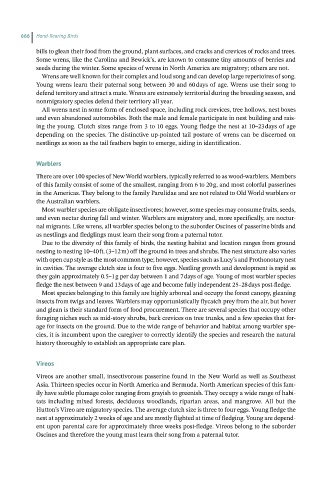Page 665 - Hand rearing birds second
P. 665
666 Hand-Rearing Birds
bills to glean their food from the ground, plant surfaces, and cracks and crevices of rocks and trees.
Some wrens, like the Carolina and Bewick’s, are known to consume tiny amounts of berries and
seeds during the winter. Some species of wrens in North America are migratory; others are not.
Wrens are well known for their complex and loud song and can develop large repertoires of song.
Young wrens learn their paternal song between 30 and 60 days of age. Wrens use their song to
defend territory and attract a mate. Wrens are extremely territorial during the breeding season, and
nonmigratory species defend their territory all year.
All wrens nest in some form of enclosed space, including rock crevices, tree hollows, nest boxes
and even abandoned automobiles. Both the male and female participate in nest building and rais-
ing the young. Clutch sizes range from 3 to 10 eggs. Young fledge the nest at 10–23 days of age
depending on the species. The distinctive up‐pointed tail posture of wrens can be discerned on
nestlings as soon as the tail feathers begin to emerge, aiding in identification.
Warblers
There are over 100 species of New World warblers, typically referred to as wood‐warblers. Members
of this family consist of some of the smallest, ranging from 6 to 20 g, and most colorful passerines
in the Americas. They belong to the family Parulidae and are not related to Old World warblers or
the Australian warblers.
Most warbler species are obligate insectivores; however, some species may consume fruits, seeds,
and even nectar during fall and winter. Warblers are migratory and, more specifically, are noctur-
nal migrants. Like wrens, all warbler species belong to the suborder Oscines of passerine birds and
as nestlings and fledglings must learn their song from a paternal tutor.
Due to the diversity of this family of birds, the nesting habitat and location ranges from ground
nesting to nesting 10–40 ft. (3–12 m) off the ground in trees and shrubs. The nest structure also varies
with open cup style as the most common type; however, species such as Lucy’s and Prothonotary nest
in cavities. The average clutch size is four to five eggs. Nestling growth and development is rapid as
they gain approximately 0.5–1 g per day between 1 and 7 days of age. Young of most warbler species
fledge the nest between 9 and 13 days of age and become fully independent 25–28 days post‐fledge.
Most species belonging to this family are highly arboreal and occupy the forest canopy, gleaning
insects from twigs and leaves. Warblers may opportunistically flycatch prey from the air, but hover
and glean is their standard form of food procurement. There are several species that occupy other
foraging niches such as mid‐story shrubs, bark crevices on tree trunks, and a few species that for-
age for insects on the ground. Due to the wide range of behavior and habitat among warbler spe-
cies, it is incumbent upon the caregiver to correctly identify the species and research the natural
history thoroughly to establish an appropriate care plan.
Vireos
Vireos are another small, insectivorous passerine found in the New World as well as Southeast
Asia. Thirteen species occur in North America and Bermuda. North American species of this fam-
ily have subtle plumage color ranging from grayish to greenish. They occupy a wide range of habi-
tats including mixed forests, deciduous woodlands, riparian areas, and mangrove. All but the
Hutton’s Vireo are migratory species. The average clutch size is three to four eggs. Young fledge the
nest at approximately 2 weeks of age and are mostly flighted at time of fledging. Young are depend-
ent upon parental care for approximately three weeks post‐fledge. Vireos belong to the suborder
Oscines and therefore the young must learn their song from a paternal tutor.

